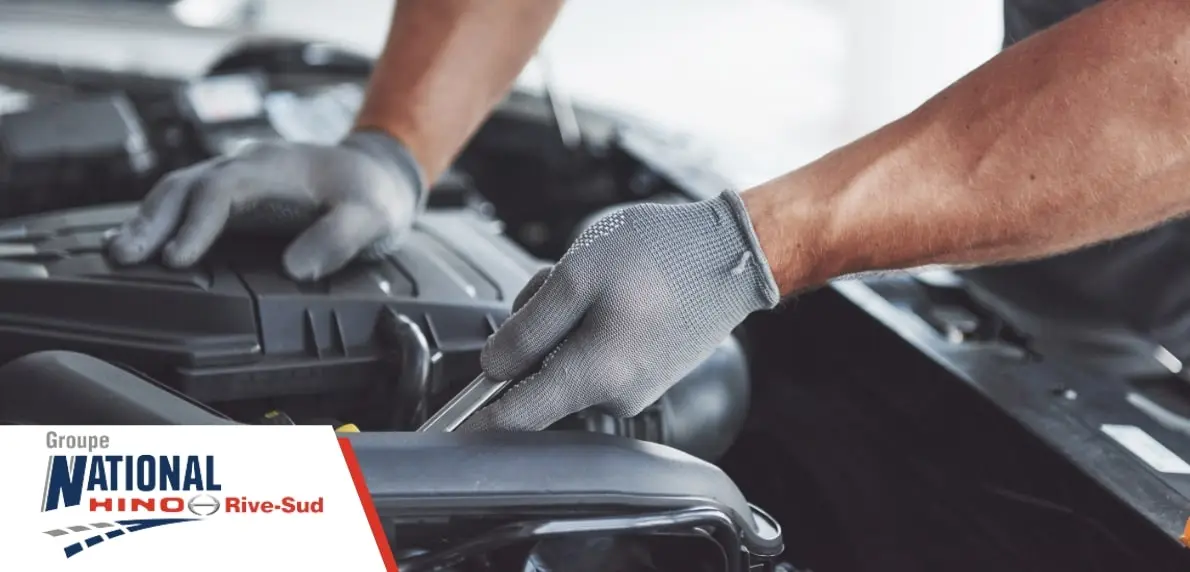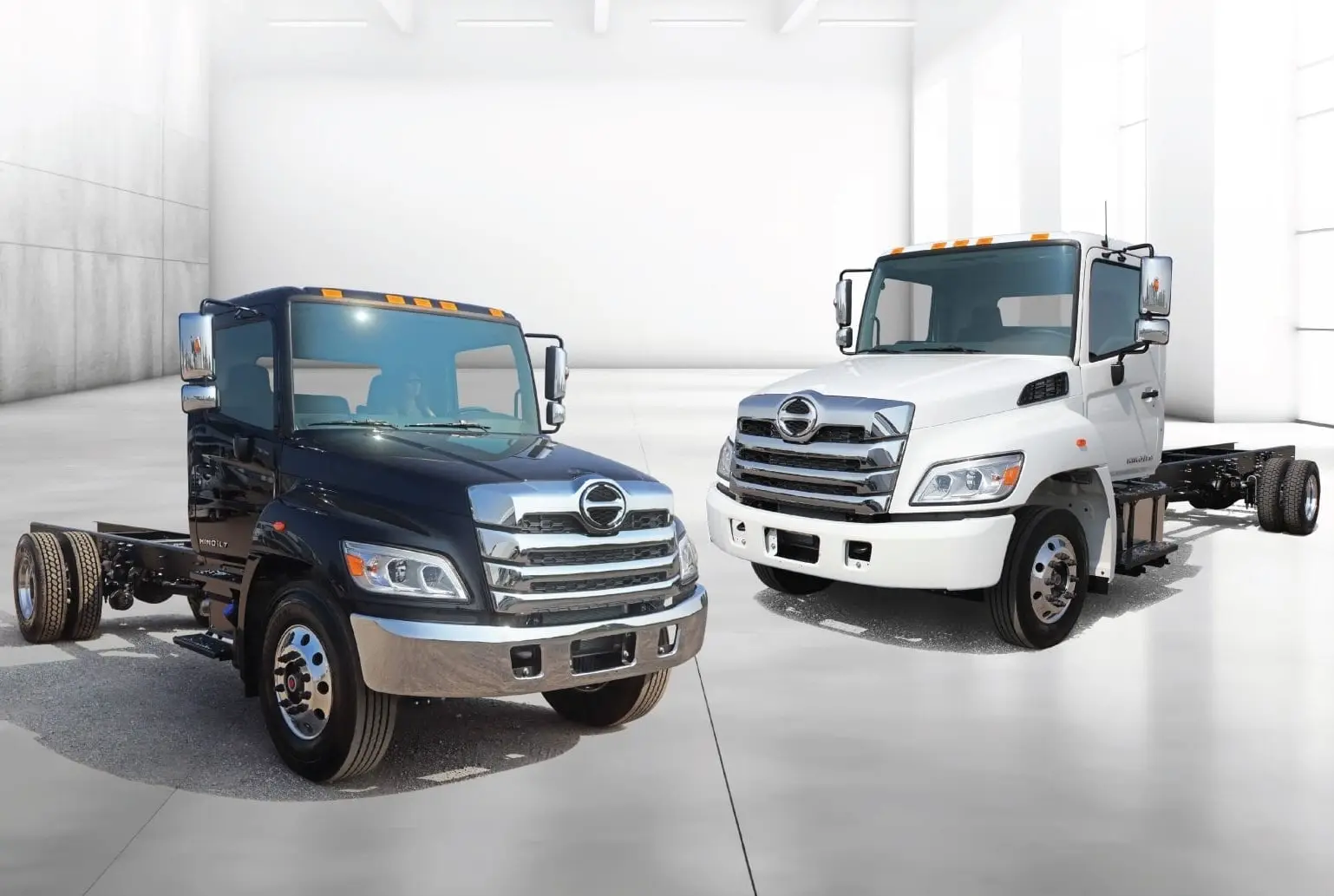Need help or informations ? Call us : (450) 641-1115
0.00 $
No products in the cart.
Hino truck maintenance: 7 essential tips for lasting reliability

Your Hino truck maintenance is an important investment that deserves careful attention to avoid costly breakdowns on the road. Every delayed oil change or neglected filter progressively reduces the reliability of your vehicle, and can compromise the safety of your travels, whether you’re criss-crossing the South Shore or other regions of Quebec.
In this article, discover seven practical tips to help you maintain performance and extend service life.
7 essentail points to remember when servicing your truck:
- Change oil regularly at the indicated intervals
- Ensure proper filter replacement (Air, Fuel, Oil)
- Perform a regular brake inspection on your morning rounds before taking your truck out on the road.
- Carry out a tire inspection as part of your morning check-up (look for signs of punctures, uneven tire wear, etc.).
- Check the cooling system and maintain it regularly to prevent overheating during operation.
- Inspect your suspension, steering and flashers on your morning rounds
- Ensure optimum lubrication of transmission and steering components.
Regular truck oil changes
The truck oil change is an important pillar in the maintenance of your Hino truck. This vital liquid creates a protective film between metal parts, reduces friction and removes metal particles that accumulate during operation. The quality of the oil plays a decisive role in the longevity of your engine, especially for models that carry heavy loads.
The right, clean oil considerably extends the life of your Hino truck. By changing your oil at the recommended intervals, you can prevent premature component wear and avoid costly repairs.
This small, regular investment saves you thousands of dollars in mechanical costs, and keeps your vehicle at peak performance on Quebec roads. Good maintenance helps prevent breakdowns, but if you have a problem on the road, don’t forget our mobile roadside assistance service.
| Hino model | Type of use | Interval (km) |
|---|---|---|
| 300 series | General purpose | 15 000 – 20 000 |
| 500 series | Long distance | 20 000 – 30 000 |
| All models | Severe conditions | 15,000 (or less) |
| Note: Always check the owner’s manual and manufacturer’s recommendations. | ||
Replacing your truck’s filters
Regular filter replacement in your Hino truck plays an important role in engine longevity. These small parts ensure that only clean air and filtered fuel reach your engine, while the oil filter captures harmful impurities. A truck with filters in good condition offers better throttle response and reduces the risk of mechanical breakdowns during your journeys.
Clogged filters quickly turn your Hino into a fuel sink. A clogged air filter can increase fuel consumption by up to 25%. In addition, a clogged fuel filter can damage the fuel injection system, leading to repairs that are far more costly than a simple preventive replacement. The quality of your journeys on Quebec roads depends directly on it.
Knowing how to identify the warning signs of a faulty filter is crucial.
- Lack of power: A drop in engine power may indicate a clogged air filter.
- Jerking: A dirty fuel filter can cause jerking during acceleration.
- Smoke: Excessive smoke may indicate a problem with the fuel filter.
Regular inspection of truck brakes
Inspecting the brakes on your Hino truck is more than just a formality. It’s an important step in ensuring the safety of everyone on the road. A morning safety check is essential, while a thorough inspection is recommended every 80,000 km or 24 months by qualified technicians. A truck with defective brakes quickly becomes a public hazard, whether you’re on the South Shore or elsewhere in Quebec.
The main items to check are brake pads, discs and brake fluid level. Since the brake oil level naturally drops as the brakes wear, checking it can give you a valuable clue to the overall condition of the system. Contaminated fluid can cause leaks and corrode internal components. Hino trucks are designed to be robust, but no vehicle is immune to wear and tear on mechanical parts.
Don’t forget to have a mechanical inspection of your Hino truck according to SAAQ standards.
Here are the key steps for a complete brake inspection.
- Check: Inspect brake pad thickness for wear.
- Test: Evaluate braking efficiency to ensure optimum performance.
- Monitoring: Check the hydraulic system for leaks and problems.
Checking truck tires
Regular monitoring of your tires plays an important role in the safety and efficiency of your Hino truck. Tires in good condition ensure optimum grip on Quebec roads, especially in difficult conditions. In addition to improving handling, properly inflated tires significantly reduce fuel consumption. A significant saving when you consider that every kilometer counts towards your profitability.
To check your tires effectively, adopt a few simple but effective techniques. Measure the tread depth with a special gauge to make sure it exceeds the 1.6 mm required by law in Quebec. Also examine the surface for any cuts or embedded objects. Don’t forget to rotate your tires regularly to ensure even wear and prolong their life. This preventive maintenance practice will save you a lot of trouble on the road.
Hino Truck maintenance: Cooling system
The cooling system on your Hino truck plays a vital role in preventing the engine from overheating. An overheated engine can cause serious and costly damage, not to mention breakdowns that can leave you by the roadside. The ideal engine temperature ensures optimum combustion and prolongs engine life. Hino trucks are renowned for their reliability, but even the best mechanics need a cooling system in top condition.
Neglecting to maintain the cooling system can lead to a significant drop in your truck’s performance. A poorly tensioned fan belt reduces air and fluid circulation, causing a gradual rise in temperature. A clogged radiator cap disrupts the water cycle, while a faulty thermostat blocks fluid circulation. Not to mention that a faulty fan clutch can quickly lead to tank boiling. In these situations, it’s best to contact specialized technicians for a quick inspection.
During your regular checks, pay close attention to several key elements of the cooling system. Start by inspecting the coolant level and quality when the engine is cold. Examine hoses for cracks or signs of wear that could lead to leaks. Check the tension and condition of the fan belt. Make sure that the radiator is not blocked by debris or mud, which could reduce its efficiency. To ensure the safety and longevity of your vehicle on Quebec roads, don’t hesitate to call on Hino truck maintenance experts.
Suspension and steering inspection
Keeping your Hino truck’s suspension and steering systems in top condition ensures optimum control on Quebec roads. When these systems show signs of wear, handling becomes hazardous, especially when cornering or performing emergency maneuvers. Fatigued ball joints disrupt wheel alignment, making the vehicle less predictable. Faulty suspension also increases the risk of an accident, since braking distance is considerably longer on wet roads.
There are a number of items that deserve special attention when inspecting your Hino truck. Shock absorbers, the first weak link in the chain, should be checked for oil leaks or corrosion. Leaf springs, typical of heavy trucks, can crack over time. Tie-rods and ball joints, subjected to severe stress, wear progressively and create play in the steering wheel. Careful inspection of these chassis components will save you many surprises on the road, and prolong the life of your tires, which will wear evenly.
Lubricating mechanical components
Regular lubrication of your Hino truck’s moving parts is not an option, but essential to keep your vehicle in top condition. Good grease creates a protective film between metal surfaces, reducing the friction and wear that lead to costly breakdowns. Trucks subjected to the harsh conditions of Quebec’s roads are particularly in need of this meticulous attention to extend the life of their mechanical components.
Universal joints, steering knuckles and wheel bearings are among the priority areas for lubrication on your Hino truck. A well-established schedule will help avoid premature wear and noises that often indicate a lack of grease. Lubricant quality is just as important as frequency of application, so always consult your service manual for the precise specifications recommended by the manufacturer.
Comparison
Prioritizing the maintenance items on your Hino truck requires a strategy adapted to your daily use. For a truck that mainly travels the urban roads of the South Shore, the focus should be on the brakes and suspension, which are put under more stress by frequent stops.
Long-haul trucks, on the other hand, require special attention to the cooling system and lubrication of components to withstand hours of continuous driving. Costs vary according to the item being serviced, but neglect your maintenance and it’s your wallet that will suffer later.
A goodpreventive maintenance programis always a worthwhileinvestment compared to emergency repairs, which can cost up to three times as much. For complete maintenance of your Hino truck, including prioritization of items according to your use, contact our experts. Call us today to set up a customized maintenance plan that will ensure the longevity of your vehicle.
| Maintenance item | Frequency | Importance |
|---|---|---|
| Oil change | 15,000 – 30,000 km | Essential |
| Brake inspection | Every morning (safety patrol) | Vitale |
| Filter replacement | 15,000 – 20,000 km | Important |
| Tire inspection | Regular | Important |
| Note: Regular maintenance extends truck life and ensures safety. | ||
Keeping your Hino truck in top condition is not only a question of performance, but also of safety and long-term savings. By following these preventive maintenance tips, from regular oil changes to thorough brake inspections, you’ll protect your investment and ensure your vehicle’s reliability on Quebec’s roads. A well-maintained truck is a truck that will faithfully accompany you for years to come.
Hino truck maintenance FAQs
What's the best motor oil for a Hino truck?
Selecting the ideal motor oil for your Hino truck depends above all on the specific model and its year of construction. It is therefore essential to consult your owner’s manual in order to scrupulously follow the manufacturer’s recommendations. This will enable you to choose the right oil for your vehicle’s technical requirements.
AMSOIL recommends the use of its 15W-40 100% heavy-duty synthetic diesel oil, or its 15W-40 and 5W-40 Signature Series 100% maximum protection synthetic diesel oils. Kroon-Oil also offers oils specifically designed for different Hino models and climatic conditions, such as Armado Synth LSP 10W-40 for Hino Series Dutro / 300 Euro 4.
Does the Hino truck belong to Toyota?
Hino Motors, well known as Hino, is a truck and bus manufacturer and an integral part of the Toyota Group. Based in Hino, a suburb of Tokyo, Japan, the company works closely with Toyota to innovate in the commercial vehicle sector.
In 2021, Hino, Isuzu and Toyota announced a strategic partnership focused on commercial vehicles, aimed at accelerating the adoption of new technologies and promoting a sustainable transportation industry. This collaboration includes the development of battery electric vehicles (BEVs) and fuel cell electric vehicles (FCEVs), as well as autonomous driving technologies.
Recent articles
- All Post
- Employment
- Non classifié(e)
- Security
- Services
- Technology
- Transport
- Truck



More articles



Hino South Shore Dealer in Boucherville | Truck Service and Maintenance
Ensure that your trucks remain efficient, safe and ready to face the challenges of the road.
Need informations ?
All rights reserved © Groupe National Hino.INC. Powered by WebPlify



